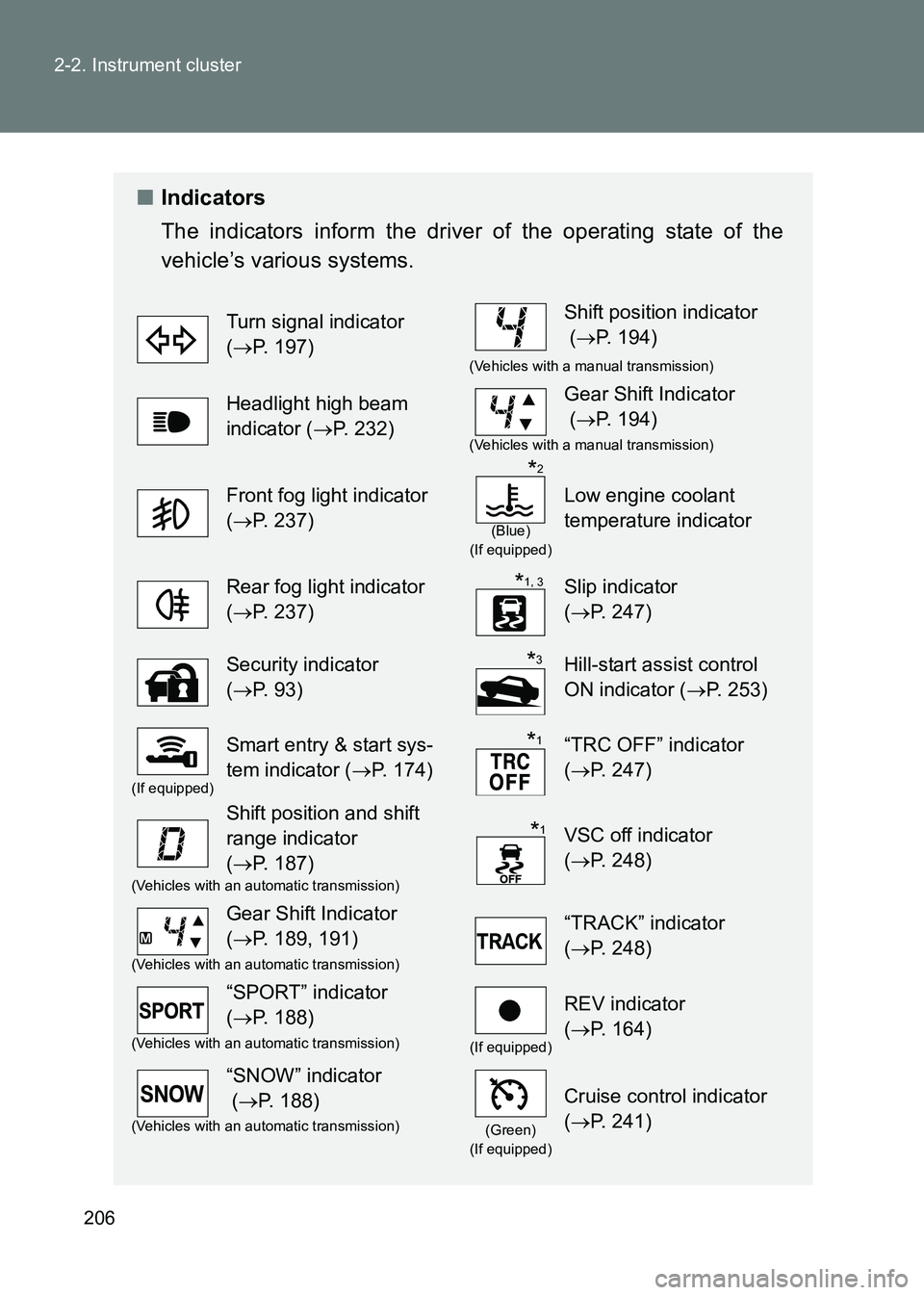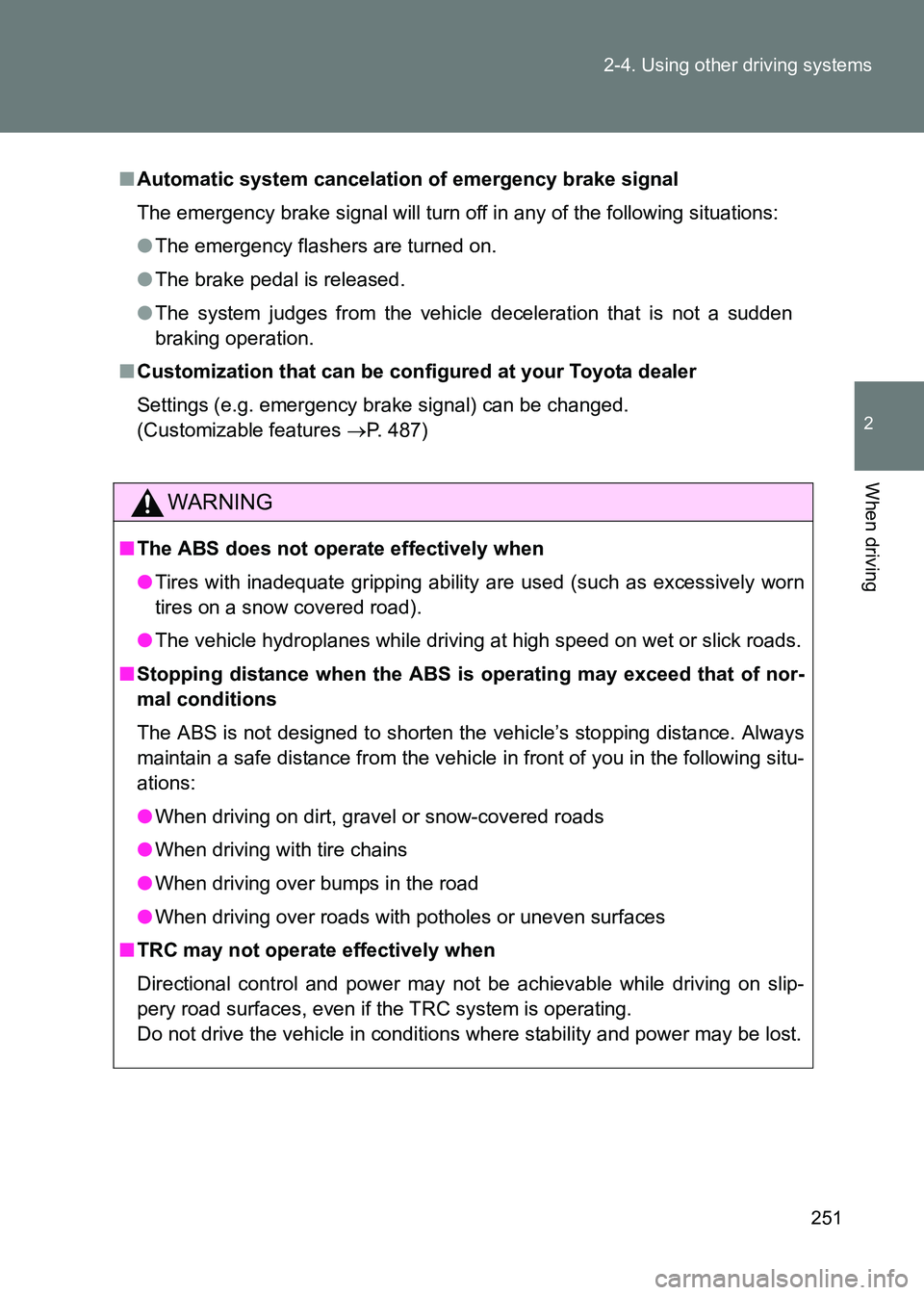Page 206 of 505

206
2-2. Instrument cluster
86_EE (OM18071E)
■
Indicators
The indicators inform the driver of the operating state of the
vehicle’s various systems.
Turn signal indicator
(→ P. 197)Shift position indicator
(→ P. 194)
(Vehicles with a manual transmission)
Headlight high beam
indicator ( →P. 232)Gear Shift Indicator
(→ P. 194)
(Vehicles with a manual transmission)
Front fog light indicator
(→ P. 237)
(Blue)
(If equipped)
Low engine coolant
temperature indicator
Rear fog light indicator
( → P. 237)Slip indicator
(→ P. 247)
Security indicator
(→ P. 9 3 )Hill-start assist control
ON indicator ( →P. 253)
(If equipped)
Smart entry & start sys-
tem indicator ( →P. 174)“TRC OFF” indicator
(→ P. 247)
Shift position and shift
range indicator
(→ P. 187)
VSC off indicator
(→ P. 248)
(Vehicles with an automatic transmission)
Gear Shift Indicator
(→ P. 189, 191)“TRACK” indicator
(→ P. 248)
(Vehicles with an automatic transmission)
“SPORT” indicator
(→ P. 188)
(If equipped)
REV indicator
(→ P. 164)
(Vehicles with an automatic transmission)
“SNOW” indicator
(→ P. 188)
(Green)
(If equipped)
Cruise control indicator
( → P. 241)
(Vehicles with an automatic transmission)
*2
*1, 3
*3
*1
*1
Page 246 of 505

246
2-4. Using other driving systems
86_EE (OM18071E)
Driving assist systems
To help enhance driving safety and performance, the following sys-
tems operate automatically in response to various driving situations.
Be aware, however, that these systems are supplementary and
should not be relied upon too heavily when operating the vehicle.
■ ABS (Anti-lock Brake System)
Helps to prevent wheel lock when the brakes are applied suddenly, or if
the brakes are applied while driving on a slippery road surface
■Brake assist
Generates an increased level of braking force after the brake pedal is
depressed when the system detects a panic stop situation
■VSC (Vehicle Stability Control)
Helps the driver to control skidding when swerving suddenly or turning
on slippery road surfaces
■TRC (Traction Control)
Helps to maintain drive power and pr event the drive wheels from spin-
ning when starting the vehicle or accelerating on slippery roads.
The TRC system is also equipped with the brake LSD function.
■ Hill-start assist control
→
P. 253
■EPS (Electric Power Steering)
Employs an electric motor to reduce the amount of effort needed to turn
the steering wheel
■Emergency brake signal
When the brakes are applied suddenly, the emergency flashers auto-
matically flash quickly to alert the vehicle behind.
Page 250 of 505

250
2-4. Using other driving systems
86_EE (OM18071E)
■
Automatic reactivation of TRC and VSC systems
After turning the TRC and VSC systems off, the systems will be automati-
cally reactivated in the following situations:
●Vehicles without a smart entry & start system: When the engine switch is
turned to “LOCK” position
● Vehicles with a smart entry & start system: When the “ENGINE START
STOP” switch is turned off
● If only the TRC system is turned off, the TRC will turn on when vehicle
speed is more than approximately 50 km/h (31 mph).
If both the TRC and VSC systems are turned off, automatic reactivation
will not occur when vehicle speed increases.
■ Reduced effectiveness of the EPS system
The effectiveness of the EPS system is reduced to prevent the system from
overheating when there is frequent steer ing input over an extended period of
time. The steering wheel may feel heavy as a result. Should this occur,
refrain from excessive steering input or stop the vehicle and turn the engine
off. The EPS system should return to normal after a little while.
■ Automatic deactivation of “TRACK” mode
Vehicles without a smart entry & start system
When the engine switch is turned to “LOCK” position after driving in
“TRACK” mode, the mode is automatically deactivated.
Vehicles with a smart entry & start system
When the “ENGINE START STOP” switch is turned off after driving in
“TRACK” mode, the mode is automatically deactivated.
■ Operating conditions of emergency brake signal
When the following three conditions are met, the emergency brake signal
will operate:
●The emergency flashers are off.
● Actual vehicle speed is over 60 km/h (38 mph).
● The brake pedal is depressed in a manner that cause the system to
judge from the vehicle deceleration that this is a sudden braking opera-
tion.
Page 251 of 505

251
2-4. Using other driving systems
2
When driving
86_EE (OM18071E)
■
Automatic system cancelation of emergency brake signal
The emergency brake signal will turn off in any of the following situations:
●The emergency flashers are turned on.
● The brake pedal is released.
● The system judges from the vehicle deceleration that is not a sudden
braking operation.
■ Customization that can be conf igured at your Toyota dealer
Settings (e.g. emergency brake signal) can be changed.
(Customizable features →P. 487)
WARNING
■The ABS does not operate effectively when
●Tires with inadequate gripping ability are used (such as excessively worn
tires on a snow covered road).
● The vehicle hydroplanes while driving at high speed on wet or slick roads.
■ Stopping distance when the ABS is operating may exceed that of nor-
mal conditions
The ABS is not designed to shorten the vehicle’s stopping distance. Always
maintain a safe distance from the vehicle in front of you in the following situ-
ations:
●When driving on dirt, gravel or snow-covered roads
● When driving with tire chains
● When driving over bumps in the road
● When driving over roads with potholes or uneven surfaces
■ TRC may not operate effectively when
Directional control and power may not be achievable while driving on slip-
pery road surfaces, even if the TRC system is operating.
Do not drive the vehicle in conditions where stability and power may be lost.
Page 368 of 505
368
4-3. Do-it-yourself maintenance
86_EE (OM18071E)
16SPARE See note. Spare fuse
17SPARE See note. Spare fuse
18SPARE See note. Spare fuse
19SPARE See note. Spare fuse
20SPARE See note. Spare fuse
21ST 7.5 A Starting system
22ALT-S 7.5 A Charging system
23(STR LOCK) 7.5 A Steering lock system
24D/L 20 A Power door lock
25ETCS 15 A Engine control unit
26(AT+B) 7.5 A Transmission
27(AM2 NO. 2) 7.5 A Smart entry & start system
28EFI (CTRL) 15 A Engine control unit
29EFI (HTR) 15 A
Multiport fuel injection system/
sequential multiport fuel injection
system
30EFI (IGN) 15 A Starting system
31EFI (+B) 7.5 A Engine control unit
32HAZ 15 A
Turn signal lights, emergency
flashers
33MPX-B 7.5 AAutomatic air conditioning system,
gauge and meters
34F/PMP 20 AMultiport fuel injection system/
sequential multiport fuel injection
system
35IG2 MAIN 30 A
SRS airbag system, engine control
unit
36DCC 30 AInterior light, wireless remote con-
trol, main body ECU
FuseAmpereCircuit
Page 372 of 505
372
4-3. Do-it-yourself maintenance
86_EE (OM18071E)
Light bulbs
You may replace the following bulbs by yourself. The difficulty level
of replacement varies depending on the bulb. As there is a danger
that components may be damaged, we recommend that replacement
is carried out by any authorized Toyota dealer or repairer, or another
duly qualified and equipped professional.
■Preparing a replacement light bulb
Check the wattage of the light bulb being replaced. ( →P. 484)
■ Front bulb locations
Side turn
signal lights
Page 374 of 505
374
4-3. Do-it-yourself maintenance
86_EE (OM18071E)
Replacing light bulbs
■ Side turn signal lights
Turn the steering wheel in the
opposite direction of the light to
be replaced.
Turn the steering wheel to a point
that allows your hand to easily fit
between the tire and fender liner.
Remove the clip and partly
remove the fender liner.
To prevent damage to the vehicle,
cover the tip of the screwdriver
with a rag.
Release the light’s claw.
Insert the screwdriver into the
hole. While firmly pushing the
screwdriver forward, move it
towards the inside of the vehicle.
To prevent damage to the vehicle,
wrap the tip of the screwdriver
with a tape.
STEP 1
STEP 2
STEP 3
Page 379 of 505
379
4-3. Do-it-yourself maintenance
4
Maintenance and care
86_EE (OM18071E)
■
Replacing the following bulbs
If any of the lights listed below has burnt out, have it replaced by
any authorized Toyota dealer or repairer, or another duly qualified
and equipped professional.
●Headlights
● Front position lights/daytime running lights
● Front turn signal lights
● Front fog lights
● Stop/tail lights
● Stop lights
● Rear turn signal lights
● High mounted stoplight
● Door courtesy lights (if equipped)